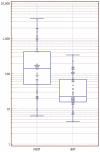The serum CA-125 concentration data assists in evaluating CT imaging information when used to differentiate borderline ovarian tumor from malignant epithelial ovarian tumors
- PMID: 21852906
- PMCID: PMC3150673
- DOI: 10.3348/kjr.2011.12.4.456
The serum CA-125 concentration data assists in evaluating CT imaging information when used to differentiate borderline ovarian tumor from malignant epithelial ovarian tumors
Abstract
Objective: We wanted to evaluate the diagnostic value of serum CA-125 concentration, when used in combination with the preoperative contrast-enhanced CT results, to differentiate borderline ovarian tumors (BOTs) from stage I malignant epithelial ovarian tumors (MEOTs).
Materials and methods: Ninety-eight masses (46 BOTs and 52 stage I MEOTs) from 87 consecutive patients (49 with BOTs and 38 with stage I MEOTs) who had undergone preoperative contrast-enhanced computed tomography (CT) and surgical staging were evaluated retrospectively and independently by two radiologists. The preoperative serum CA-125 concentration was measured in all patients. The utility of analyzing serum CA-125 concentration in combination with the CT results was evaluated by receiver operating characteristic (ROC) curve analysis.
Results: An irregular tumor surface and lymphadenopathy were predictive of a MEOT. ROC analysis showed that the combination of CT data and the serum CA-125 level resulted in a higher diagnostic performance than did using the CT alone for differentiating BOTs from MEOTs. The areas under the curves (AUCs) without and with the use of the serum CA-125 level data were 0.67 (95% confidence interval [CI]: 0.57-0.77) and 0.78 (95% CI: 0.68-0.85), respectively, for reader 1 (p = 0.029) and 0.71 (95% CI: 0.61-0.80) and 0.81 (95% CI: 0.72-0.89), respectively, for reader 2 (p = 0.009).
Conclusion: The serum CA-125 concentration is of additional diagnostic value when used in conjunction with the CT imaging results for differentiating BOTs from MEOTs.
Keywords: Borderline ovarian tumor; CA-125; CT; Malignant ovarian tumor.
Figures




Similar articles
-
Quantitative analysis of the MRI features in the differentiation of benign, borderline, and malignant epithelial ovarian tumors.J Ovarian Res. 2022 Jan 22;15(1):13. doi: 10.1186/s13048-021-00920-y. J Ovarian Res. 2022. PMID: 35062992 Free PMC article.
-
Preoperative CA-125 levels in 123 patients with borderline ovarian tumors: a retrospective analysis and review of the literature.Int J Gynecol Cancer. 2009 Nov;19(8):1335-8. doi: 10.1111/IGC.0b013e3181a83e04. Int J Gynecol Cancer. 2009. PMID: 20009886
-
Is there a correlation between tumor marker panel and tumor size and histopathology in well staged patients with borderline ovarian tumors?Acta Obstet Gynecol Scand. 2007;86(4):484-90. doi: 10.1080/00016340701226138. Acta Obstet Gynecol Scand. 2007. PMID: 17486473
-
CA 19-9 in evaluation of adnexal mass: retrospective cohort analysis and review of the literature.Int J Biol Markers. 2015 Jul 22;30(3):e333-40. doi: 10.5301/jbm.5000139. Int J Biol Markers. 2015. PMID: 25704505 Review.
-
Added value of contrast-enhanced ultrasound (CEUS) in the diagnosis of primary retroperitoneal serous adenocarcinoma: a case report.BMC Med Imaging. 2021 May 12;21(1):80. doi: 10.1186/s12880-021-00613-4. BMC Med Imaging. 2021. PMID: 33980163 Free PMC article. Review.
Cited by
-
Habitat-based radiomics for preoperative differentiation between early-stage serous borderline ovarian tumors and malignant ovarian tumors.Front Oncol. 2025 May 20;15:1559398. doi: 10.3389/fonc.2025.1559398. eCollection 2025. Front Oncol. 2025. PMID: 40463871 Free PMC article.
-
Does the Reporting Quality of Diagnostic Test Accuracy Studies, as Defined by STARD 2015, Affect Citation?Korean J Radiol. 2016 Sep-Oct;17(5):706-14. doi: 10.3348/kjr.2016.17.5.706. Epub 2016 Aug 23. Korean J Radiol. 2016. PMID: 27587959 Free PMC article.
-
Radiomics nomogram for preoperative differentiation of early-stage serous borderline ovarian tumors and serous malignant ovarian tumors.Front Oncol. 2024 Jan 15;13:1269589. doi: 10.3389/fonc.2023.1269589. eCollection 2023. Front Oncol. 2024. PMID: 38288103 Free PMC article.
-
Computed Tomography Indicators for Differentiating Stage 1 Borderline Ovarian Tumors from Stage I Malignant Epithelial Ovarian Tumors.Diagnostics (Basel). 2023 Jan 28;13(3):480. doi: 10.3390/diagnostics13030480. Diagnostics (Basel). 2023. PMID: 36766584 Free PMC article.
-
Genital Schistosomiasis: A Report on Two Cases of Ovarian Carcinomas Containing Viable Eggs of Schistosoma mansoni.Case Rep Obstet Gynecol. 2014;2014:508718. doi: 10.1155/2014/508718. Epub 2014 Dec 22. Case Rep Obstet Gynecol. 2014. PMID: 25587473 Free PMC article.
References
-
- Jones MB. Borderline ovarian tumors: current concepts for prognostic factors and clinical management. Clin Obstet Gynecol. 2006;49:517–525. - PubMed
-
- Bell DA, Longacre TA, Prat J, Kohn EC, Soslow RA, Ellenson LH, et al. Serous borderline (low malignant potential, atypical proliferative) ovarian tumors: workshop perspectives. Hum Pathol. 2004;35:934–948. - PubMed
-
- Tinelli R, Tinelli A, Tinelli FG, Cicinelli E, Malvasi A. Conservative surgery for borderline ovarian tumors: a review. Gynecol Oncol. 2006;100:185–191. - PubMed
-
- Cadron I, Leunen K, Van Gorp T, Amant F, Neven P, Vergote I. Management of borderline ovarian neoplasms. J Clin Oncol. 2007;25:2928–2937. - PubMed
-
- Holschneider CH, Berek JS. Valvar cancer. In: Berek JS, Novak E, editors. Berek & Novak's gynecology. 14th ed. Philadelphia: Lippincott Williams & Wilkins; 2007. pp. 1549–1580.
Publication types
MeSH terms
Substances
LinkOut - more resources
Full Text Sources
Medical
Research Materials
Miscellaneous

